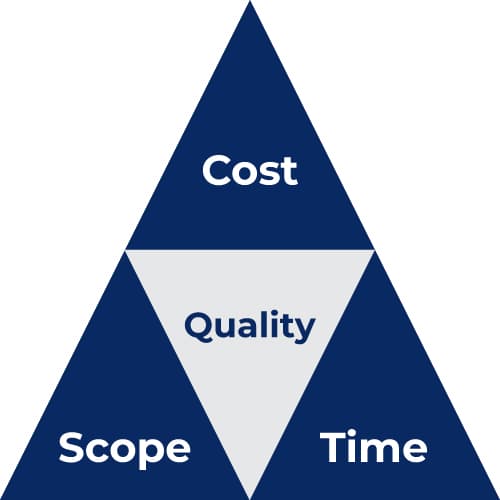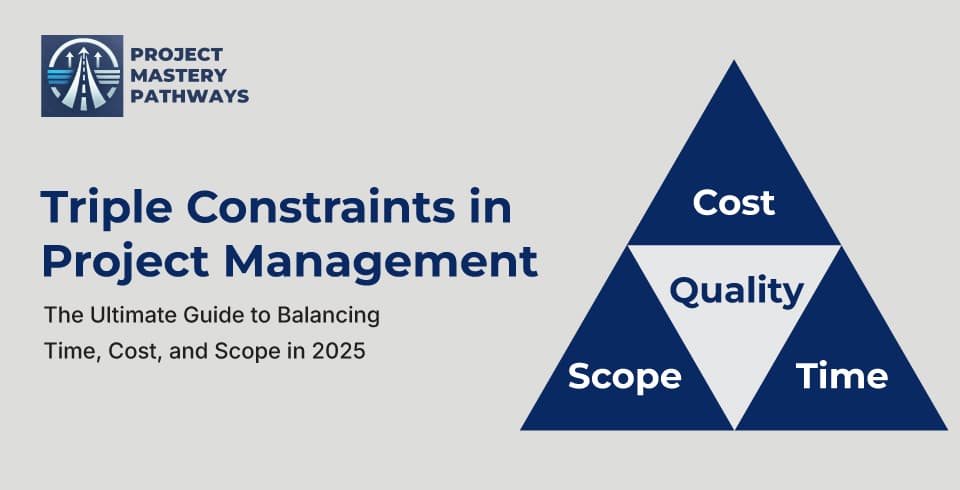Are you struggling to explain to stakeholders why adding “just one more feature” will impact your project timeline or budget? Do you find yourself caught between competing demands of delivering fast, cheap, and high-quality results? You’re not alone. Every project manager who has known the frustration of trying to keep their team productive with too little time, not enough budget, and an impossibly large scope has experienced the project management triangle in action.
Understanding the triple constraints of project management is your secret weapon for managing expectations, making informed decisions, and delivering successful projects. By the end of this blog, you’ll master the art of balancing scope, time, and cost – and learn how to communicate trade-offs effectively to stakeholders without compromising project quality.
What Are Triple Constraints in Project Management?
The triple constraints, also known as the Iron Triangle or Project Management Triangle, represent the three fundamental limitations that govern every project: scope, time, and cost. These three factors are interconnected so that if one changes, then another must also change in a defined and predictable way.
Think of it this way: “Do you want fast, cheap, or good?” That’s the essential question of the project management triangle. The reality is, you can’t have all three simultaneously without making strategic trade-offs.
Let’s break down each constraint:
Scope refers to all the work, deliverables, and requirements needed to complete your project successfully. This includes features, functionalities, and specific outcomes that stakeholders expect.
Time represents your project schedule, deadlines, and the duration required to complete all project activities within the agreed timeline.
Cost encompasses your project budget, including resources, equipment, personnel, and any financial investments required to deliver the project.
For a deeper understanding of this concept, check out this comprehensive explanation: What is Triple Constraints in Project Management?
The Interdependent Relationship: Why Changes in One Affect All Others
A change in one constraint often affects the others. For example, shortening the project timeline (time) may require additional resources (cost) or a reduction in project deliverables (scope).

Here’s how these relationships work in practice:
Scope vs. Time and Cost: Scope is directly proportional to both time and cost, which means it moves in the same direction as those factors. When scope increases, time and money must also increase in order to tackle a larger project.
Time vs. Cost: These two factors have an inversely proportional relationship. These two factors move in opposite directions. If costs need to be cut, then deadlines will have to be extended; but if you encounter a sudden time crunch, you’ll need extra budget to adjust to shorter timelines.
Consider this real-world example: A marketing team is preparing campaign materials for a product launch. The client suddenly requests five additional promotional pages. Since the launch date cannot be moved (time constraint remains fixed), the project manager must either increase the budget to hire additional designers or reduce other deliverables from the original scope.
For more insights on effective project planning strategies, explore our guide on How to Design Project Planning Templates: A Comprehensive Guide for Aspiring Project Managers in 2025.
Practical Strategies for Managing Triple Constraints
Successfully managing triple constraints requires a proactive approach and clear communication with stakeholders. Here are proven strategies to help you navigate these challenges:
1. Establish Priorities Early It pays to set clear expectations with your client about which part of the triangle takes priority. Before your project begins, determine which constraint is most critical and which offers the most flexibility.
2. Keep At Least One Constraint Flexible While every project has its limitations, it is highly advised to keep at least one constraint flexible. When all three constraints on a project are fixed, it prevents the team from adjusting to change, especially on longer projects, which can severely affect quality.
3. Monitor and Communicate Continuously Regular project reviews help identify potential issues and take corrective actions. Effective stakeholder communication ensures you manage changes smoothly. Set up regular check-ins to assess constraint status and address issues before they become major problems.
4. Use Modern Project Management Tools Project management software like Jira provides a comprehensive project planning, tracking, and management platform. It offers features like Gantt charts, budget tracking, and resource allocation. These tools provide real-time visibility into your constraints and help you make data-driven decisions.
Beyond the Traditional Triangle: Modern Approaches to Project Constraints
While the traditional triple constraint model remains foundational, some project management experts have added three more constraints to the model, to better reflect the most critical areas of a project. These additional constraints include:
Quality: The standards and performance criteria that your deliverables must meet Risk: Potential threats and uncertainties that could impact your project Resources: The people, skills, and tools available to execute your project
Professionals with high business acumen understand that project performance extends beyond the traditional iron triangle of budget, scope, and schedule. Instead, they continuously reassess performance parameters amid change and evaluate projects across multiple dimensions to ensure both business value and operational success.
This evolution reflects the increasing complexity of modern projects and the need for project managers to consider broader success factors beyond just time, cost, and scope.
Remember, understanding project constraints is just one piece of the project management puzzle. To deepen your expertise and advance your career prospects, consider pursuing relevant certifications. Learn more about Why Get a PMP Certification in 2025? Is It Still Worth It for Your Career? to understand how professional credentials can enhance your project management capabilities.
Take Your Project Management Skills to the Next Level
Mastering the triple constraints is essential for project management success, but it’s just the beginning of your journey. The project management triangle helps project managers with informed decision-making and expectation management, which ultimately leads to more successful project execution.
Ready to deepen your understanding and develop practical skills? Subscribe to my educational content on PMPwithRay for expert insights, real-world examples, and proven strategies that will accelerate your project management career.
For comprehensive training that covers not just triple constraints but all essential project management competencies, enroll in my project management courses on Udemy. These courses are designed specifically for aspiring project managers and provide the knowledge foundation you need to succeed in this dynamic field.
Your success as a project manager depends on understanding these fundamental concepts and applying them consistently. Start building your expertise today – your future projects and stakeholders will thank you for it.

